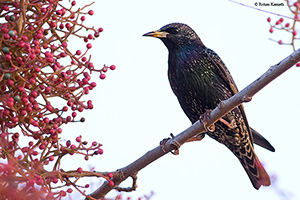Nest Sanitation |
|
|---|---|

 photographs of a European Starling and White-breasted Nuthatch by Rohan Kamath |
The
very fragility of nests may be adaptive in forcing many
birds to build a new nest every year; nests that do not
deteriorate over the winter can harbor potentially lethal
numbers of parasites or pathogens that may withstand the
cold and await returning nesters. Indeed, despite their
appearance as peaceful retreats, nests are often alive with
invertebrates feeding on the birds, on the birds' waste
products, or on each other. Infestations of parasites (fly
maggots, fleas, ticks, and mites) or pathogens (bacteria and
fungi) are discouraged by various means. One that is widely
used is, of course, removal of the fecal sacs of the
young. Recent work has shown that many birds repeatedly add green leaves or cedar bark with pesticidal properties to their nests. This behavior has been recorded in numerous birds of prey that often reuse old nests (some kites, many hawks, and most eagles) and in some passerines (especially secondary cavity nesters, such as European Starlings and Purple Martins). Interestingly, nuthatches, which are also secondary cavity nesters, ritually smear pine pitch and rub insects around the entrance of their holes instead of adding fresh greenery. Both the pitch and the defensive chemicals of the insects may discourage parasites. Many birds avoid reusing old nests, even if the nests do not deteriorate over the winter. When heavy parasite infestations do occur, nestling mortality rises, nests may be deserted, and in extreme cases, entire colonies have been known to move to a new location. |
| SEE:
Masterbuilders;
Nest Materials;
Nest Lining;
Feathered Nests;
Disease and Parasitism;
Incubation: Heating Eggs. Copyright ® 1988 by Paul R. Ehrlich, David S. Dobkin, and Darryl Wheye. |
|